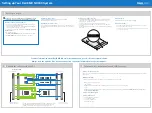
149
D-Link G416 User Manual
Appendix C - Wireless Security
Wireless Security
This section will show you the different levels of security you can use to protect your data from intruders. The router offers the
following types of security:
• WPA3 (Wi-Fi Protected Access 3)
• WPA2 (Wi-Fi Protected Access 2)
• WPA2-PSK (Pre-Shared Key)
• WPA (Wi-Fi Protected Access)
• WPA-PSK (Pre-Shared Key)
What is WPA?
WPA (Wi-Fi Protected Access), is a Wi-Fi standard that was designed to improve the security features of WEP (Wired
Equivalent Privacy).
The 2 major improvements over WEP:
• Improved data encryption through the Temporal Key Integrity Protocol (TKIP). TKIP scrambles the keys using a
hashing algorithm and by adding an integrity-checking feature, ensures that the keys haven’t been tampered
with. WPA2 is based on 802.11i and uses Advanced Encryption Standard (AES) instead of TKIP.
• User authentication, which is generally missing in WEP, through the extensible authentication protocol (EAP). WEP
regulates access to a wireless network based on a computer’s hardware-specific MAC address, which is relatively
simple to be sniffed out and stolen. EAP is built on a more secure public-key encryption system to ensure that
only authorized network users can access the network.
WPA-PSK/WPA2-PSK/WPA3-SAE uses a passphrase or key to authenticate your wireless connection. The key is an alpha-
numeric password between 8 and 63 characters long. The password can include symbols (!?*&_) and spaces. This key must
be the exact same key entered on your wireless router or access point. Further, The Simultaneous Authentication of Equals
(SAE) of WPA3 enhances the protection against dictionary attacks.
WPA/WPA2 incorporates user authentication through the Extensible Authentication Protocol (EAP). EAP is built on a more
secure public key encryption system to ensure that only authorized network users can access the network.
WPA 3 has the strongest security among these with the increased cryptographic capability and the requirements of the
Protected Management Frames (PMFs) to protect from snooping attack.
















































